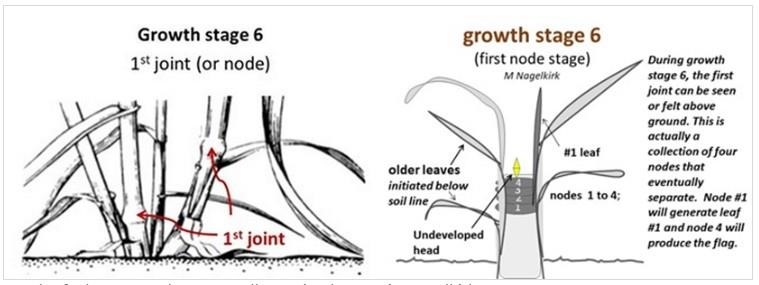By Jenna Falor
In the U.S., we measure wheat growth using the Feekes growth stages. But can you identify these stages and know which ones are most important to your management decisions? Feekes growth stage 6 is the next major growth stage of importance. This is when the first node is visible.
When wheat reaches each development stage depends on temperature and plating date. Most of the wheat crop in the south is at Feekes 6 and in the north Feekes 4-5. Feekes 6 is the point at which the meristematic tissue converts from vegetative (leaf) development to reproductive. The point from early Feekes 6 to about Feekes 6.5 (approximately 10-14 days) is the time spikelets are forming and the size of the head is determined (called terminal spikelet). At this point, any additional tiller that form will not influence yield. The head and spikelets can already be seen if you split the stem in half lengthwise at this stage.
This is a very important growth stage and you should learn to properly identify it.
How to identify Feekes 6
- Pull or dig a couple groups of plants from different parts of the field.
- Identify the main stem; these are usually the largest and thickest stems.
- Pull the lower leaves off from the stem one by one.
- Look for a node in the section you pulled leaves from, it appears at the soil level first, then extends up as the plant grows. A node is where the stem looks swollen and is typically a darker shade of green from the rest of the stem.
 Graph of wheat growth stage 6. Illustration by Martin Nagelkirk.
Graph of wheat growth stage 6. Illustration by Martin Nagelkirk.Why is this stage important for management?
At this stage, most nitrogen applications should already be completed because Feekes 6 marks the beginning of rapid nitrogen uptake. This also marks the cut-off for select herbicides such as 2-4D, dicamba, PowerFlex, Osprey and Curtail. It also alerts us to the fact other crop protection products will have a cut-off within a couple weeks depending on temperature. The following products have cut-offs before the end of growth stage 7: Affinity, Harmony, Huskie, Quelex and Palaside. Michigan State University Extension advises that any time you apply pesticides, be sure to follow the label instructions.
Source : msu.edu